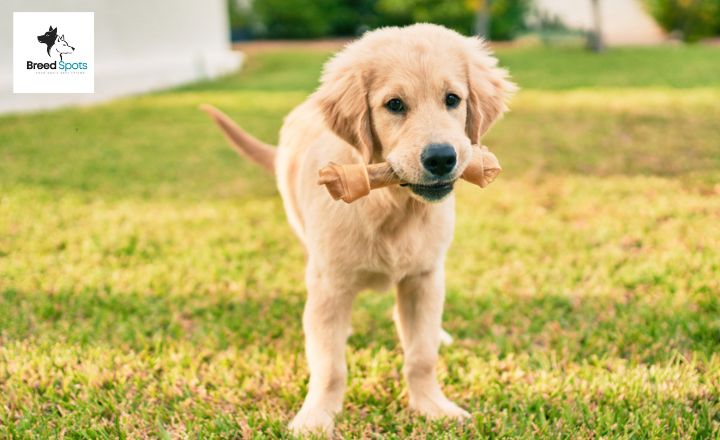Welcome to the world of Miniature Labrador Retrievers, a captivating twist on one of America’s favorite dog breeds.
These pint-sized pups are not just adorable; they bring endless joy to families and individuals alike, combining the iconic traits of Labs with an appealingly diminutive stature.
But before you rush out to adopt one of these little furballs, there’s much more to know about their unique characteristics, health considerations, and training needs.
In this article, we’ll explore the fascinating realm of Miniature Labradors, unraveling myths, exploring their origins, and shedding light on what makes them stand out from their larger counterparts.
Is There Such A Thing As A Miniature Labrador?

Miniature Labradors, as a concept, spark the curiosity of many dog enthusiasts. While the Labrador Retriever is typically beloved for its sturdy frame and playful nature, breeders have begun to claim the existence of smaller versions.
However, it’s essential to approach this topic cautiously; true Miniature Labradors do not exist in recognized breed standards.
What often passes as miniatures are variations in size within a litter or crossbreeds with smaller breeds like Beagles or Cocker Spaniels.
Interestingly, this trend raises questions about genetics and breeding ethics. The allure of a pint-sized version of such a pleasant breed stems from desire—whether for companionship or portability. Yet, it risks promoting unhealthy breeding practices that prioritize aesthetics over health.
Like any different teacup version of a dog, miniature Labradors can be bred in several ways.
1. Mini Lab As A Result Of Crossbreeding
Mini labs, born from the innovative crossbreeding approach, showcase a compelling fusion of traits that captivate dog enthusiasts and breeders alike.
These pint-sized canines combine the intelligence and trainability of a Labrador Retriever with the hypoallergenic coat qualities of a Poodle, resulting in an adorable package that harmonizes both function and form.
The distinctive appearance, often characterized by curly fur and expressive eyes, not only appeals to pet lovers but also addresses common concerns regarding shedding and allergies.
Beyond their endearing aesthetics, mini-labs exemplify how crossbreeding can enhance behavioral traits.
This hybrid vigor promotes excellent health and longevity and creates dogs that are often more adaptable to various living situations.
2. Dwarfism In Labradors

While rare, dwarfism in Labradors is a fascinating topic that illuminates the complexities of canine genetics.
This condition, often related to a genetic mutation impacting bone growth, results in dogs that exhibit shorter limbs and altered body proportions.
It is crucial to understand that these variations can have significant implications for the dog’s appearance, health, and mobility.
Dogs with dwarfism may face unique challenges, such as joint problems or issues with agility, prompting owners to adapt their care approach.
Remarkably, many dwarf Labradors maintain vibrant personalities typically associated with their breed, affectionate and eager to please.
Their distinct physical characteristics can make them more endearing, fostering a deeper bond between dog and owner as they navigate life together.
3. Breeding Runt Dogs
Breeding runt dogs often draws mixed opinions, yet this niche practice can offer remarkable insights into canine genetics and temperament.
Runt dogs, typically the smallest in their litter, possess unique traits that can influence appearance and behavior in subsequent generations.
By carefully selecting runts for breeding, enthusiasts might aim to preserve desirable characteristics and cultivate resilience and adaptability.
Due to their resource struggles, these smaller pups may develop stronger bonds with their owners early on, leading to affectionate and loyal companions.
What Is The Difference Between A Lab And A Mini Lab?

While often overshadowed by the stereotype of larger, boisterous Labradors, this small Labrador embodies a unique charm that makes it an exceptional companion.
Unlike its bigger counterparts, who may dominate playtime with raw energy and vitality, this pint-sized pup brings a refreshing gentleness and infectious enthusiasm.
Its diminutive stature means it’s more agile in navigating cozy spaces perfect for apartment living while possessing the same unwavering loyalty inherent in the breed.
Their fundamental contrast is, clearly, their size. This is why we call them miniature Labradors. For numerous of these puppies, this will be the sole difference. Sometimes, people will not even notice that they own a mini Lab.
If a Lab is your dream dog for a happy life, but the size of the dog makes you doubtful that you will have a Lab running around at a fast pace around your apartment, the smaller breed takes up way less space and might be a good option.
Mini Lab: Basic Traits
Let’s learn about the Mini Lab’s temperament, appearance, and health.
Temperament
Temperament Mini Lab dogs are often celebrated for their blend of playfulness and loyalty, making them ideal companions for families and individuals.
These spirited little canines inherit the best traits from their Labrador Retriever lineage, boasting a friendly demeanor that can brighten any room.
Their natural curiosity drives them to explore their surroundings, providing endless entertainment and fostering an engaging bond with their owners.
How Does The Mini Lab Look?
The Mini Lab Dog is a charming blend of the Labrador Retriever and another small breed. It boasts an appealing appearance that is both adorable and striking.
Their expressive eyes shine with intelligence and warmth, often framed by soft, floppy ears that enhance their playful demeanor.
The coat can vary widely depending on the other breed in the mix but often retains the sleek, water-resistant quality characteristic of Labs, resulting in a pup that’s not only cute but also practical for various weather conditions.
One of the most delightful aspects of Mini Lab Dogs is their compact size, which does not compromise the signature Labrador personality traits.
Typically weighing 20 to 40 pounds, they bring all the enthusiasm and affection we love about Labs into a smaller package.
What Is The Weight Of A Mini Lab

One must appreciate the diverse factors when considering the weight of a Mini Labradoodle, an intriguing mix of Labrador Retriever and Poodle.
Once fully grown, these delightful dogs typically weigh between 15 and 30 pounds, but their size can vary significantly based on genetics and breeding practices.
Mini Labradoodles are often created by crossing a standard Poodle with a smaller breed or utilizing a miniature version of the Poodle itself.
This intentional mixing leads to variations in height and weight that can pique interest among potential dog owners.
The Height Of A Miniature Lab
The allure of a Miniature Lab dog, known for its compact size and charismatic personality, presents a unique blend of charm and functionality.
Typically standing between 18 to 22 inches tall at the shoulder, these little hybrids boast an appearance that belies their robust energy levels.
This diminutive stature makes them ideally suited for urban lifestyles where space is often at a premium.
Owners can easily manage their playful antics within the constraints of smaller homes or apartments.
Common Health Issues With The Mini Lab
Mini Lab Dogs, a delightful blend of loyalty and playfulness, are often susceptible to specific health issues that potential owners should consider.
One of the most common concerns is hip dysplasia, a genetic condition that affects the formation of the hip joint.
This sickness can lead to discomfort and mobility challenges as your dog ages. Regular veterinary check-ups, maintaining an optimal weight, and engaging in low-impact exercise can significantly mitigate these risks.
The Lifespan Of A Miniature Labrador Retriever
Though not officially recognized as a distinct breed, the lifespan of a miniature Labrador Retriever typically mirrors that of its larger counterparts, averaging around 10 to 14 years.
However, this can be influenced by genetics, diet, exercise routine, and overall care. Interestingly, many pet owners are drawn to the smaller versions for their manageable size yet abundant energy and playfulness.
This makes it essential for miniature enthusiasts to remain vigilant about their health needs; regular veterinary check-ups can help identify potential genetic issues before they become significant problems.
Pros And Cons Of The Teacup Lab
The Teacup Lab, focusing on breeding smaller dog breeds, presents a unique appeal for prospective pet owners.
One of the most significant advantages is their commitment to health and ethics. They often prioritize responsible breeding practices that can lead to healthier puppies.
The intimate size of teacup breeds makes them suitable for apartment living. They attract those who may prefer companions that require less physical space—ideal for busy city dwellers or individuals seeking low-maintenance pets.
However, the joys of owning a teacup breed come with their own set of challenges. Due to their tiny stature, these dogs are often more susceptible to health issues such as dental problems or fragile bones.
Owners might navigate complex care requirements and potential vet bills that can spiral due to breed-specific complications.
Moreover, constant supervision can become overwhelming for some; teacups aren’t just cute accessories—they demand attentive care that may not suit everyone’s lifestyle.
Balancing the pros and cons becomes essential in determining whether the charm of a teacup pup aligns with your life’s rhythm and responsibilities.
The Verdict
The concept of a miniature Labrador has sparked significant debate among dog enthusiasts and breeders alike.
While some argue that miniaturizing this beloved breed preserves its charm while catering to the demand for smaller companions, others raise ethical concerns about the health implications of extreme size variations.
Breeders often face scrutiny over potential genetic disorders that can manifest in these pint-sized pups, leading many to question whether it’s worth risking a dog’s well-being for aesthetic preferences.
Furthermore, the popularity of miniature Labradors highlights an intriguing shift in consumer behavior towards “designer” or unconventional pet breeds. This trend reflects broader societal changes.
However, one must ask if breeding practices are evolving responsibly or simply capitalizing on market trends without considering long-term consequences for canine health.
Ultimately, the final verdict rests on individual preference and how we prioritize animal welfare as our definitions of companionship evolve.

